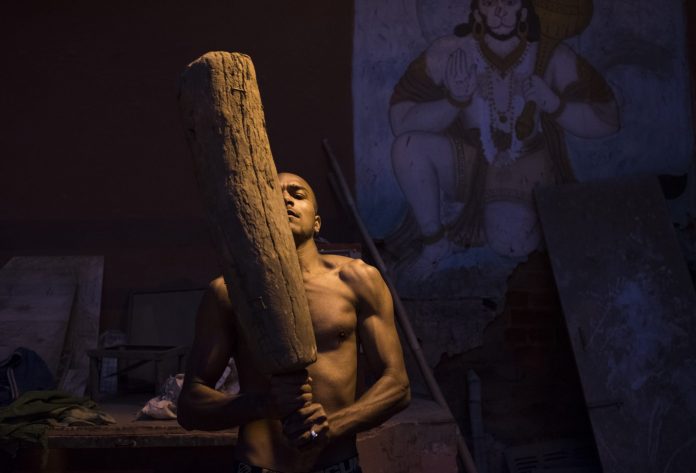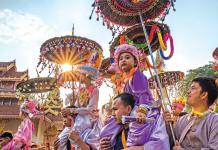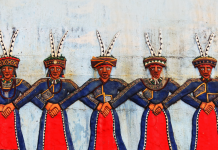Indian kushti is considered the predecessor of all wrestling. It is undergoing a revival despite the tug-of-war between tradition and modernity
Text Zigor Aldama
Photos Miguel Candela
It’s 4:30 in the afternoon. The merciless sun above Haryana starts to sink towards the mirage-like blur of the horizon. The unbearable heat begins to give in, and life slowly crawls back out of its lethargy into the chaotic streets of this state in northwest India.
This is the time that a group of local wrestlers have been eagerly waiting for. They travel by motorcycle or auto rickshaw – the three-wheeler used as a taxi – to an isolated building in the middle of a road about 70 kilometres from the national capital, Delhi.
They enter the simple akhara – the fighting arena where they will wrestle one another in the same way that their ancestors had done before them.
“Nobody can precisely trace the origins of kushti”, Mohit Saroha, lawyer for the Kushti Association of India, claims. “Some say it dates back three thousand years, while most will settle the origins at around the 5th century BC. It was called malla-yuddha before, and it spread rapidly across South Asia after the establishment of the Mughal Empire” (between the 16th and 18th centuries). Despite this debate on the origins of the sport, nobody in India disputes that kushti is the predecessor of all wrestling styles practiced today.
“It has evolved to become Greco-Roman and modern free-style wrestling, but these are still kushti at heart”, adds Deepak Ansuia Prasad, a former wrestler and one of the most knowledgeable journalists covering the sport.

Forged in tradition
Kushti feels somewhat archaic, not only because it’s played in the mud, with wrestlers wearing only a janghia – a loincloth – but also because it requires fighters, called pehlwan, to follow an ascetic life, reminiscent of the times when wrestlers were revered and considered as pure as monks. “Smoking, drinking and sex are forbidden, and their diet consists only of chapatti, fruit, almonds, ghee, and milk”, explains the group’s trainer – referred to as the ustad or ‘guru’ – while his pupils change clothes and warm up.
Added to this sense of ancient history is the ritual of the sport, which has religious elements. A good example of this is the manner in which all wrestlers enter the akhara. First, they need to bow in front of the sculpture of the monkey god, Hanuman. Then, they must reverently salute their guru and ‘bathe’ themselves in holy smoke.
Around thirty men and boys – aged seven and above – gather here. Some wrestlers reportedly do around 3,000 push-ups everyday to build muscle. Then, there is running and weight lifting. All of them must be able to climb a thick rope which hangs from a 20-metre high tree using only their bare hands and feet.
The children find training strenuous; their faces contort in a grimace of pain. They are soaked in sweat, but not one gives up, even when they are requested to carry a heavy doughnut-shaped stone around their necks. They come from across Haryana and live in the surrounding rural areas where the essence of kushti is preserved.
“There are also akharas in big cities, but many of the wrestlers there train on mats, not in mud, and prefer newer styles of wrestling. This way, they can hope to reach international competitions”, Saroha points out.
In fact, if traditional kushti is now enjoying a revival after a long period of decadence, which started during the British colonial era, this is mostly owing to a monumental achievement by an Indian wrestler. Sushil Kumar, who trained in mud akharas, won a bronze medal in the 2008 Beijing Olympic Games and the World Wrestling Championship 2010, as well as a silver medal in the 2012 London Olympic Games. “It’s because of him, a national hero who was born very near to my village, that I decided to start training in kushti”, a young kid called Kumar explains after planking for a couple of minutes. Because he is among the youngest of the group, Kumar is in charge of setting up the arena for the fight. Using a hoe, he stirs the surface. Then, he uses a long piece of wood to flatten it. Finally, a splash of water gives the ground the desired consistency – not hard enough to hurt, and not too soft to walk on. “The core of kushti training has not changed over the course of history. Unlike in other sports, technology is never used to improve performance. It’s as primitive as it gets”, Prasad laughs.

At 5:30pm, when the temperature drops to around 30 degrees, the fight begins. The youngsters enter the arena first. As tradition dictates, they bless themselves, rubbing a handful of mud onto their chests, and then shake hands. The first one to pin his rival’s shoulders and hips to the ground at the same time wins the round. “It’s more about skills than strength”, the ustad Rajan explains. Rivals look at each other in the eye, try to reach for the legs, and then the struggle makes its way to the ground. Matches can last more than half an hour, and can become very physically demanding. Although kicks and punches are not allowed, it doesn’t take long for blood to spill to the ground, often intermingled with sweat and tears. This is a particularly tough session given that the start of the tournament season is just around the corner.
Most competitions – called dangals – are held in rusty building structures on the outskirts of small and medium-sized towns. During matches, it gets so crowded inside that it becomes difficult to move, and so bets – the core business of many a sport – are shouted out loudly by members of the audience. In most places, there are no women, since they have traditionally been banned from attending and taking part in such games given the masculine tradition.
The makings of an icon
But things are changing fast. A few female teenagers have decided to challenge the status quo of the sport and, in turn, Indian society, by starting to train and compete in kushti. Female wrestler Divya Kakran even fights with men – and she seldom loses.
“I was six when I wrestled for the first time”, the 18-year-old recalls at her home in a suburb in Delhi. Her father, an ex-wrestler who never won anything, sits besides her, listening carefully. They are flanked by a wall hanging Kakran’s 43 medals. “My family needed the money, and it all started out as a joke. I was strong, so the audience at a dangal bet I wouldn’t be able to defeat a boy. But I did. I had been secretly training with a guru who didn’t mind teaching girls, and after that, I started to compete more often”.
She is not the first to break kushti’s unwritten laws banning women from the sport, but she is certainly the most successful. And now, after winning gold at the Asian Games in Greco-Roman wrestling – in the cadet category – she eyes a medal in the forthcoming 2020 Tokyo Olympic Games. “I train in traditional kushti, which is more demanding, and then learn the specific rules for other styles to compete abroad”, she says.
Unsurprisingly, she has become a role model for many other girls aspiring to train in kushti, and her growing success keeps bringing girls as young as six to the akharas. “I don’t think we challenge the historical rules of kushti. We abide by them, but take the sport into the 21st century, where the constitution states that there should be no gender discrimination”, she says.

Many disagree. “They say women can’t fight wearing only the janghia, which leaves the torso exposed. They argue that this fact distorts the techniques used to wrestle for hundreds or years. It’s true to some degree, but it’s also true that kushti took inspiration from Persian wrestling, and that many of the things that were permitted in malla-yuddha are now forbidden. India must not forget its roots, but has to keep evolving and looking forward,” says Kakran.
Thanks to the examples set by Kakran and Sushil Kumar, kushti is still alive and kicking. Dangals still attract crowds across the country, although stories of doping and rigged matches abound. “The most severe problem faced by kushti nowadays has nothing to do with the arrival of women or the evolution of rules, but with the deterioration of the ethical qualities of wrestlers”, Saroha points out. As many other kushti fans do, the lawyer melancholically remembers the legendary story of Gama, a Muslim wrestler who became a legend when he protected his Hindu neighbourhood from an attack in Pakistan during the 1947 Partition riots. “That bravery and high moral standard is what kushti has always been about”, Prasad adds. “Unfortunately, now many good wrestlers can’t even make ends meet, so they have to give up the righteous, traditional way of life to get a regular job and put fame and money first”.
For more stories and photos, check out Asian Geographic Issue 121.




![The Road to Independence: Malaya’s Battle Against Communism [1948-1960]](https://asiangeo.com/wp-content/uploads/2021/07/WhatsApp-Image-2021-07-26-at-11.07.56-AM-218x150.jpeg)






